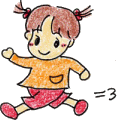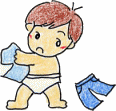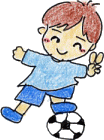All Ages
Developmental Characteristics by Age
“What will my child be like at age ♡?”
Here are some developmental characteristics of each year.
Babies say . . .

I can go all the way over there!
Babies expand their range of actions as they learn to sit, crawl, and stand.
Who is that?
Babies develop an intense fear of strangers, but recognize the faces of loved ones and enjoy being cuddled.
“Ah ee ooh. Boo boo. Koo koo.”
Babies begin to say nonsense words and pick up the intonation patterns of conversation.
I get it.
Babies learn to understand simple words and attempt to convey their feelings through gestures.
One-year-olds say . . .

Let’s go!
One-year-olds learn to walk, push, and throw.
“Mine!”
One-year-olds learn to interact with others through objects, for example, passing a ball. They also fight over toys.
“Mama.” “No.”
One-year-olds learn to understand what adults are saying, begin to call for people and use words such as “No!” often.
“Want mama.”
One-year-olds begin to speak in two-word phrases.
Two-year-olds say . . .

Ready, set, go!
Two-year-olds learn to run, jump, and control their movements.
“I do it!”
Two-year-olds want to do everything on their own, become defiant, and assert themselves.
“This is fun!”
Two-year-olds begin to say a variety of things.
“Faster!”
Two-year olds show an interest in the activities of others and often imitate them.
Three-year-olds say . . .

“I do it.“
Even if they can’t do it well yet, three-year-olds learn to do many things for themselves, such as eat and go to the bathroom.
“Here you go.”
Three-year-olds begin to share items with friends and take turns when they play.
“Why?”
Three-year-olds want to know the names of things and what they are.
“Just like Mama!”
They play make-believe, imitating the actions of the adults around them and the things they do in everyday life.
Four-year-olds say . . .

“Uh-oh. Watch out!”
Four-year-olds are able to balance their entire bodies and control their movements.
“It’s fun to play with everyone.”
Four-year-olds begin to feel the joy of spending time with friends and form stronger friendships. At the same time, their competitive spirit also awakens.
“I wonder if ________ is lonely.”
Four-year-olds begin to understand others’ feelings even if they are not outwardly expressed.
“I’m going to draw animals.”
Four-year-olds learn to create, draw, and act with a goal.
Five-year-olds say . . .

“Let’s make teams.”
Five-year-olds understand that they can accomplish more by working together.
“I get it.”
Five-year-olds listen to what their friends say and communicate their own thoughts and feelings.
“I don’t want to, but . . .”
Five-year-olds develop the discipline to do things that they don’t like.
“I’m good at drawing.”
Five-year-olds begin to develop the fine motor skills necessary to draw curved lines and write.
